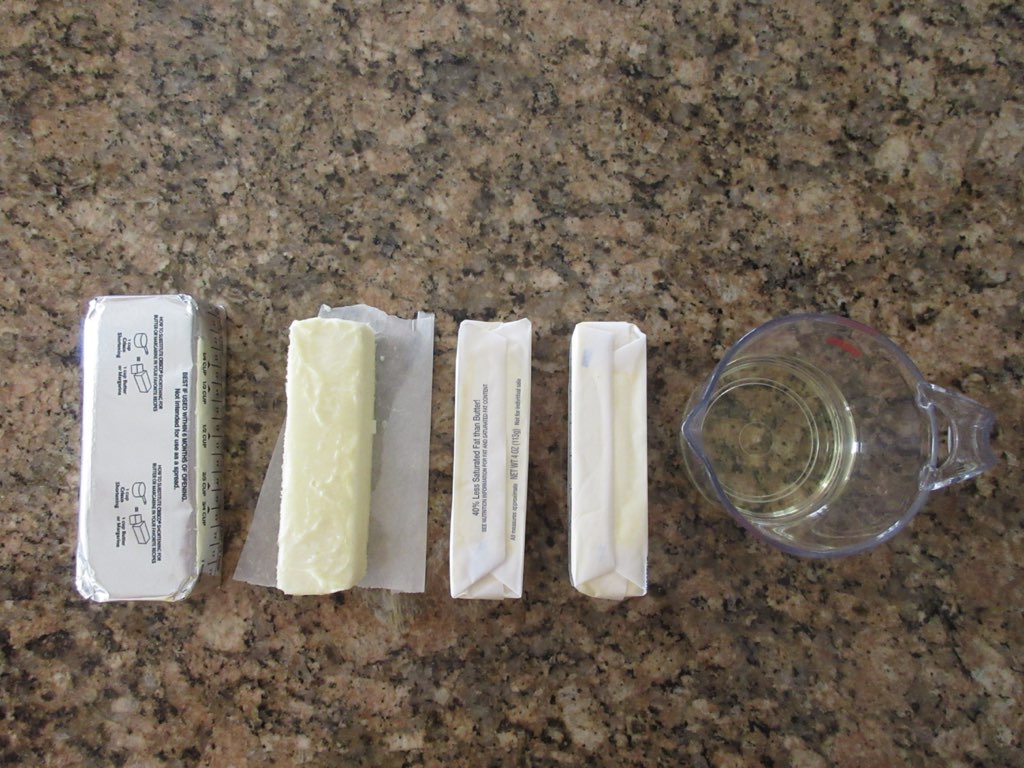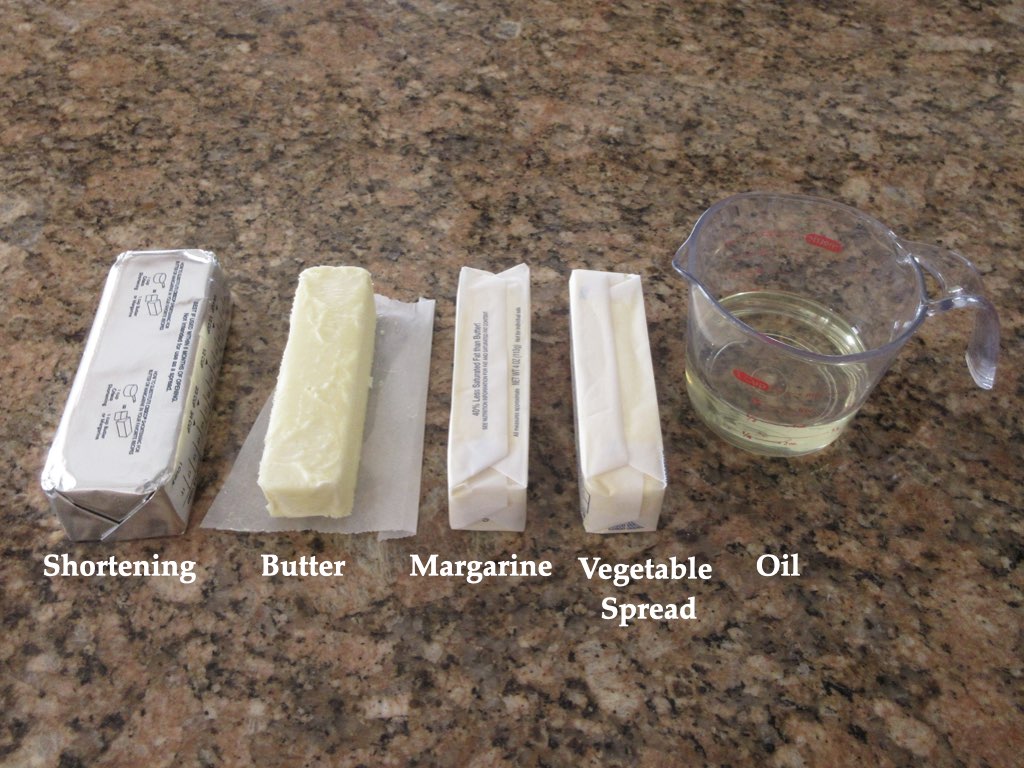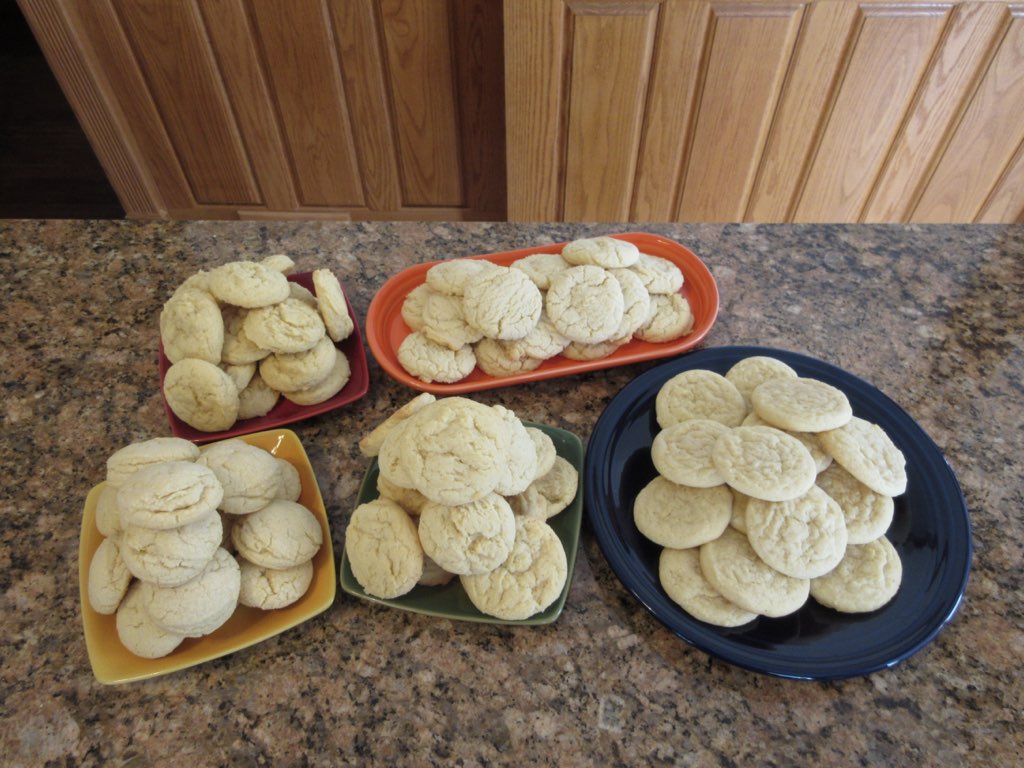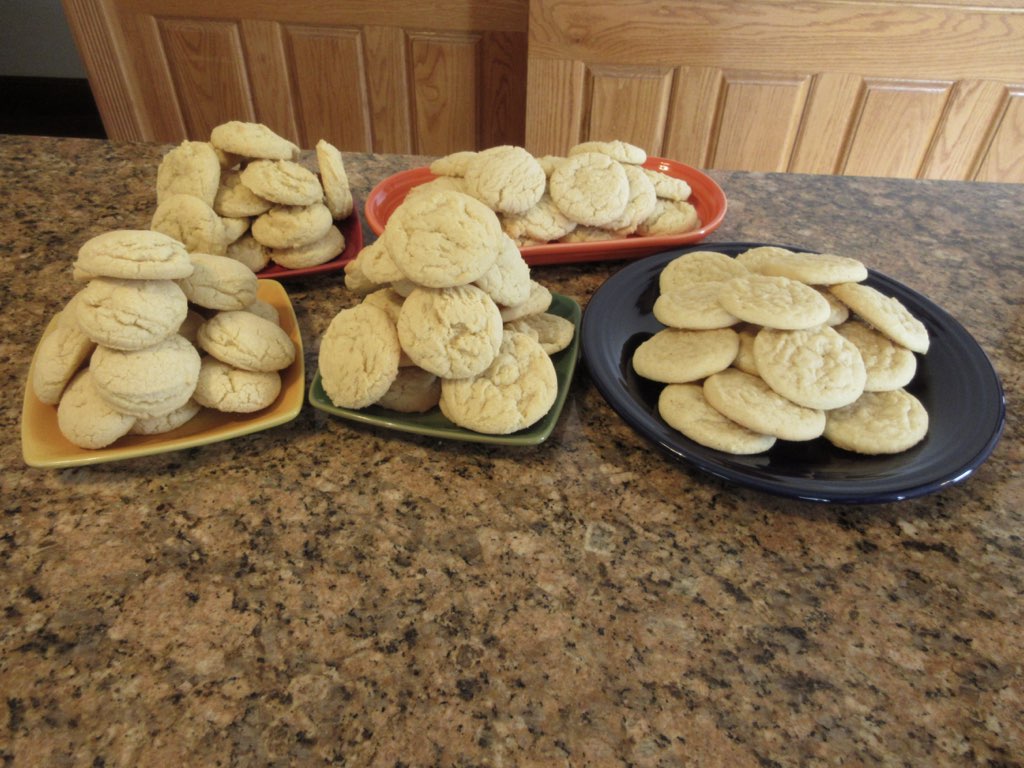When it comes to baking, you may have found yourself without a stick of butter. Or perhaps you are lactose intolerant or have other dietary restrictions. As a result, you may have reached for a common substitute or typed the following question online. What is a substitute for butter? The answer is both easy and a bit complex. The short answer is margarine or shortening are great substitutes. But there are many substitutes and each work a little differently.
You may also be wondering what is the difference between using butter, lard, margarine, oil, shortening or vegetable spread in baking. This is an excellent question! Hopefully, after reading this article, you will finally know what to use as a substitute for butter.
What are the Types of Fats?
First, what are the main types of fat used in baking? When it comes to options, you may find butter, margarine and vegetable spread in one section of the store. But then you round a corner and see shortenings, oils and lards. Which one is best? Do I chose what is on sale? Will it work in my recipe for chocolate chip cookies? The answer is maybe. Let’s examine each type and how they are similar or different from one another.


The United States Department of Agriculture or USDA have similar specifications for margarine, butter and lard. In each product, there is a maximum moisture of 20% allowed. They also state 80% of the contents must be fat. The fat can be animal fat, milk fat, plant fat or a combination of the above. Both butter and lard have naturally occuring cholesterol and margarine does not. The idea of cholesterol in food is less of a concern now than in the past. Studies have determined that it is poorly absorbed into your system if you digest it and passes through quickly. However, foods with cholesterol do naturally have saturated and trans fats, both of which you want to limit for health reasons, so limiting high cholesterol foods for that reason isn’t a bad thing.
Shortening and oil typically have 100% fat in their product. It is allowable for both shortening and oil to have up to 0.1 moisture but the some of the most popular brands and generics are 100% fat. Since the ones I use are 100% fat, we will compare those below.
Finally, vegetable spreads do not have a minimum fat percentage or a strict maximum moisture requirement like the products in the preceding paragraphs. However, we do know that to be considered margarine, it would have to have a minimum of 80% fat. That means the amount of fat in spreads contain anywhere from 79% to 0% fat. Now obviously, the consumer is buying vegetable spreads as a butter substitute, so they do expect fat in their product.
Typically, you will see ranges from 79% to 40% fat and the rest is moisture (mostly water.) My personal favorite vegetable spread only has 53% fat. And I chose it for the health benefits and price. It’s often the lowest in calories and saturated fats within the solid fats.
Several Types of Fat Illustrated

After studying the chart above, which substitute for butter looks ideal to you? If you thought lard or margarine, you are correct when you compare the percentages of fats. And if you thought to yourself vegetable spread is a poor choice, you are also partially correct. But what about using oil or shortening? They have more fat. Will that mess up the ratio? Sometimes, yes. But other times, it bumps up those cookies to extraordinary.
So What are the Differences for Baking?
Fat is essential for creating moist, tender baked goods. Fat also helps prevents the over development of gluten whereas moisture such as water helps strengthen it. Gluten is the enemy of cakes, cookies and pie crusts. But is essential for bread such as sourdoughs, pizza crusts and sandwich loaves. So when you substitute for butter or any other type of fat, it helps to know how each of the fats perform in baked goods.
Baking with Butter
Butter is often considered the gold standard today with many baked goods. A great quality butter adds a wonderful flavor, texture and browning. With the right recipe, you will have a soft, tender crumb with a buttery flavor that melts in your mouth. Its melting point is around 95F (35C) which gives a nice spread to a cookie before a crust is formed.
Even a cheap butter has a depth of flavor you can’t find in any other type of fat. There is just a richness to the cream that no substitute for butter has been able to match despite spending massive amounts of money trying. Butter gives a homemade taste to anything. Yet, it is the highest in saturated fat, trans fat and cholesterol. Also, for those with dietary restrictions, they may be wondering what to bake with instead.
Baking with Lard
Lard is considered outdated for baking, but should it be? Sure, it has more calories than butter, but it is lower in cholesterol and bad fats. You will have a tender, flaky pie crust that is absolutely wonderful. It has a depth of flavor that marries well with savory dishes such as chicken pot pie, sausage gravy and biscuits. It is very similar to shortening in how it performs. In fact, vegetable shortening can compete with animal lard for those who wanted a meat free alternative. If you have no health concerns or dietary restrictions, you should try cooking or baking with it at least once in your lifetime. Especially for a pie crust. It’s absolutely fantastic. The melting point of most lards begin around 95F (35C) which will create a similar spread to butter when baking.
Baking with Margarine
Margarine can be an excellent alternative for those wanting a healthier alternative to butter in terms of being lower in saturated fat and trans fat. Margarine is also often a dairy-free option to butter. Its melting point is around 93F (34C) which is also very similar to butter in terms of baking. So when it comes down to similar types of fat content and melting points, both lard and margarine will give you the closest texture and shape as a substitute for butter.
However, you have to carefully watch the ingredients as some of the manufacturers have started introducing milk products in a failed attempt to mimic the taste of butter. These hybrids are often the worst tasting of the group. When it comes to margarine, the texture will be very similar to butter. The taste, however is subjective. The goal is to try various brands and if you like eating it on toast or by itself, you’ll enjoy the taste in baked goods. If you don’t like the flavor, don’t bake with it as it only gets more intense after baking.
Baking with Shortening
Shortening gives a more crumbly, flaky and tender texture than butter, margarine and lard due to the higher content of fat. This leads to a surprisingly tender cake, pie crust and cookie. Shortening has a higher melting point. Shortening has an advantage to oil as it is made with emulsifiers. If you see words like monoglycerides or diglycerides in the ingredients, this is a good thing. Emulsifiers improves the texture of the baked good and gives it a more cake-like as opposed to bread-like texture because it helps coat the flour more evenly and prevents the gluten from building up too much. It also helps the spread of the baked good.
However, its melting point is higher than butter and margarine at around 110F (43C) which allows the outside of the cookie to set faster before the shortening has a chance to melt and spread. So if you like flat cookies, stick with butter or margarine.
As a result, shortening is a great substitute in baking. The one limitation is the flavor. It’s very bland so you often find extracts, spices, sugar or salt may need bumped up a bit to create a better tasting baked good. A perfect example of this is frosting. Whereas you can get by with just 1 cup of sugar with butter frostings, you may find you need three times that amount to get a pleasant tasting icing for your cupcakes.
Baking with Oil
Oil is a great substitute for butter in many recipes. It is the often the lowest in saturated and trans fats and highest in the good fats such as polyunsaturated or monounsaturated. When looking after your health, baking with oils can be a fabulous way to enjoy desserts and still look after your well being. However, it’s not perfect. Oil, unlike shortening, doesn’t typically contain emulsifiers, so the texture will vary and the spread will be minimal. Since the melting point is the lowest of the fats above all at around 25F (-4C) you will not see much of a change in shape during baking. What you see is what you get with oil. You will have to rely on other ingredients to help spread out the baked good. This means it’s not ideal for cookie recipes.
You will still have a tender crumb and a pleasant taste with many recipes. However, when baking with oil, the outside of the baked good tends to slightly harden and brown more with oil so it isn’t always ideal for cookies without a few tweaks to other parts of the recipe, but oil can be a great substitute for cakes and breads.
Baking with Vegetable Spread
Vegetable spread can work for many recipes, but it’s not for those who rely on specific fat content. All that added moisture to help reduce fat and calories comes at price. The excessive moisture will lead to unpredictable rise, browning and spread of your baked goods. Often you will get a cracker like consistency for pie crusts, soggy tasting bread in the sticky dough recipes, and tough cookies from all that added water. So for delicious short bread cookies, don’t reach for the spread as a butter substitute.
Also, vegetable spread has a melting point is around 93F (34C) which is like that of margarine. So you’d think this would lead to a similar texture. However, remember that fat and moisture content also affects how baked goods behave? Since there is a much higher ratio of moisture and a lower ratio of fat, the baked goods will often rise as the water begins to heat up and the lack of fat helps the baked good keep its shape as the crust forms. So this isn’t ideal for cookies or pie crusts, but can make great cakes and breads.
When it comes to vegetable spread, my personal advice to you is experiment. See what works and what does. But don’t beat yourself up if this substitute fails. It’s how vegetable spreads work. If you are insistent on swapping it out for other fats, get the highest percentage of fat as possible for best results.
A Note About Transfat
No matter which type of fat you decide to use for baking comes down to personal choice and sometimes convenience. However, I do urge you to look for ingredients with the least amount of saturated and trans fat per serving. These two, especially trans fats are the worst fats for promoting obesity, heart disease, strokes and death. Eat these sparingly for ideal health.
But there is a word of caution. According to the USDA, certain items that do have trace amounts of trans-fat are allowable. If the serving suggestion is below 0.5 grams, the product may tout “no trans fat!”
“The amount of trans-fat shall be reflected in the nutritional facts panel. Products
USDA Agricultural Library
with less than 0.5 g per labeled serving may be listed as 0 g trans-fat. Manufacturers may make
factual claims such as, “zero” grams of trans-fat on labels.”
So if you are a little naughty one day and eat a whole stick of butter, margarine or other products that may have trace amounts, you may find out you just ingested a lot of unhealthy trans fat in addition to all those other calories and types of fat. The moral of the story is to eat in moderation for health! An easy way to do this is when choosing a substitute for butter or other fats, pay attention to the fine details on that nutrition label.
Let’s Experiment with Fats
Today, we discussed many of the common substitutes for butter and how the type of fat used affects your recipe. But what is a better way to explain this than visually? There is nothing quite lik seeing and tasting the difference to really get a feel for baking and to expand your talents. Let’s accomplish this by using a sugar cookie recipe. In my kitchen currently, there is butter, margarine, oil, shortening and vegetable spread. So we will experiment with each of these fats and see what happens. Using the exact same measurements, we will swap out the butter in each batch and document which one looks, feels and tastes better.
We chose a cookie recipe due to its simplicity in nature. When it comes to sugar cookies, you can’t hide behind many flavors, colors or spices. Flaws will show up easily. The cookie is cheap to make and a great way to determine the baking time of your oven, find hotspots and test out new flavorings such as coconut or banana. The unassuming sugar cookie reveals all flaws in your baking. By changing out the types of fat, you will get to see how it affects the shape, texture and flavor of this simple cookie. If you like, follow along. You will learn some valuable lessons in the kitchen that will aid you for years to come.



Could you determine just by looking which cookie is which? Some are puffier than others. Some have a slightly more golden color on the bottoms. Others are chewier and some a bit crisp. But they all ended up tasting very good. Some were just excellent while others were “okay, that was great, but I don’t need another.” Let’s looked at the cookies labeled. Which ones did you guess correctly and why?

As you can see, they all look like slight variations of a sugar cookie. Some are more spread out and some are puffy. From our discussion above, if you guessed the oil and vegetable spread sugar cookies were the puffier ones, great job! Likewise with the ones made with margarine and butter being more ideal. The shortening does a little bit of both. You get a slightly puffy cookie but more width. That leads to a nice chewy, but also crisp cookie.
So if you are looking for a good butter substitute, reach for the margarine or lard. If you are without either of those, shortening is a wonderful choice as it ranks highly on blind taste tests. In fact, half of the people preferred shortening over all the choices. But in a pinch, if you are making cookies for a last minute bake sale your kid sprang on you, either vegetable spread or even oil will work well. Both will taste good and if you didn’t have any other cookies to compare them to, you wouldn’t miss a beat going in for seconds.
For more details on the subject, check out the video below that will go over the different cookies fresh out of the oven. This may make more sense when you can see the results yourself. I hope this helps you in determining what type of fat to use in your baking in the future! In the meantime, happy baking!
0 Comments